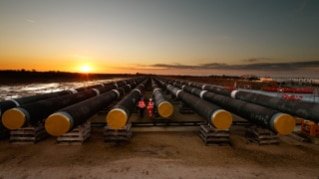National Gas is partnering with government stakeholders, regulators and industrial partners to future-proof the energy system.
With the European Union preparing to blend hydrogen into the continent’s gas transmission networks, it is also seeking to ensure the continued interoperability of local infrastructure.5 As part of this, National Gas is ramping-up the transition of the NTS to carry hydrogen and carbon dioxide through pioneering programmes including FutureGrid, Project Union and the Scottish Cluster.
Through the £12 million FutureGrid project,6 National Gas has worked closely with its technical partner DNV, regulators, academic and industrial partners to build a micro-transmission network transporting hydrogen at different blends with natural gas to test the readiness of existing infrastructure and appliances to operate safely and reliably using the lower carbon alternative. Results from the landmark initiative have demonstrated the NTS is capable of safely transporting blends of 5, 20 and 100 per cent hydrogen. As the first step needed to progress a full-scale conversation of the NTS to hydrogen, the results could help demonstrate a transition to the alternative fuel is possible in the years ahead.
National Gas has secured initial funding to advance Project Union and is currently testing the first phase of a planned 2,500-kilometre hydrogen backbone capable of transporting 100 per cent hydrogen by volume from production and storage sites to key industrial clusters nationwide. If completed, Project Union could help leverage the UK’s existing infrastructure and renewable energy potential to decarbonise heavy industry and dispatchable power generation. It also has the potential to unlock the local hydrogen economy, helping users access hydrogen via the NTS as the UK and Scottish governments pursue their plans for 10 and 5 GW of production by 2030, respectively.
In addition to supporting a growing role for hydrogen in the energy mix, National Gas is working to repurpose 300 kilometres of its network and build a further 70 kilometres of pipelines to transport carbon dioxide onshore. This work with partners around the Scottish Cluster, a collection of industrial carbon capture and carbon dioxide transportation and storage infrastructure projects, has the potential to make the technology a reality in Scotland’s industrial heartland. In doing so, it can help support the long-term future of a range of industries that are currently difficult to electrify.
By backing these pioneering initiatives and continued investment in the NTS, Macquarie believes National Gas can play an important role in the energy transition and maintain its position at the centre of the UK’s energy system.

